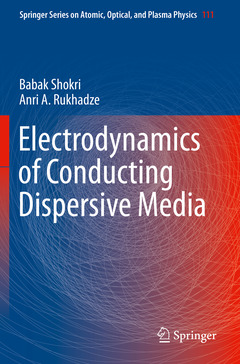Description
Electrodynamics of Conducting Dispersive Media, 1st ed. 2019
Springer Series on Atomic, Optical, and Plasma Physics Series, Vol. 111
Authors: Shokri Babak, Rukhadze Anri A.
Language: English
Subjects for Electrodynamics of Conducting Dispersive Media:
Keywords
isotropic plasma electrodynamics; electrodynamics plasma-like media; anisotropic plasma electrodynamics; dielectric permitivity; surface waves plasma layers; collisionless plasma; quantum plasma; dispersion in molecular crystals; sound waves dispersive media; current-driven plasma instabilities; fluid- and aerodynamics
Approximative price 105.49 €
In Print (Delivery period: 15 days).
Add to cartPublication date: 12-2020
485 p. · 15.5x23.5 cm · Paperback
Approximative price 105.49 €
In Print (Delivery period: 15 days).
Add to cartPublication date: 12-2019
485 p. · 15.5x23.5 cm · Hardback
Description
/li>Contents
/li>Biography
/li>Comment
/li>
Chapter One
Principles of Electrodynamics of Media with Spatial Dispersion
1.1. Equations of Electromagnetic Fields
1.2. Tensor of Complex Dielectric Permittivity
1.3. Dispersion of Dielectric Permittivity
1.4. Energy of the Electromagnetic Fields in a Medium
1.5. Electromagnetic Waves in a Medium
1.6. Plane Monochromatic Waves in a Medium
1.7. Electromagnetic Wave Propagation in a Weakly Spatial Dispersive Medium1.8. Energy Loss of Fast Moving Electrons in the Medium
1.9. Electromagnetic Field Fluctuations
1.9.1. Correlation functions and general analysis
1.9.2. Electromagnetic field fluctuations in homogenous isotropic non-grotropic media1.9.3. Casualty principle and generalization of Kramers-Kronig relations.
1.10. Electromagnetic Properties of Inhomogeneous Plasmas
1.10.1. Inhomogeneous media without spatial dispersion. Approximation of geometrical optics.
1.10.1.1. Field equation for an inhomogeneous medium without spatial dispersion
1.10.1.2. The method of geometrical optics and the WKB method
1.10.1.3. The Bohr-Sommerfeld quasi classical quantization rules
1.10.2. Approximation of geometrical optics for inhomogeneous media with spatial dispersion
1.10.2.1. Eikonal equation for inhomogeneous medium with spatial dispersion
1.10.2.2. Quantization rules
1.11. Problems
Chapter Two
Isotropic Plasma
2.1. Kinetic Equation with Self‐consistent Fields
2.2. Dielectric Permittivity of Collisionless Isotropic Plasma
2.3. Dielectric Permittivity and Electromagnetic Oscillations of Isotropic Collisionless Nonrelativistic Electron Plasma
2.4. Dielectric Permittivity and Electromagnetic Oscillations of Relativistic Collisionless Electron Plasma
2.5. Oscillations of Isotropic Electron‐Ion Plasma
2.6. Hydrodynamics of Collisionless Plasma
2.7. Dielectric Permittivity of Plasma; Taking account of Particle Collisions
2.8. Boundary Problem of Fields in Plasma
2.9. Reflection and absorption of electromagnetic Waves in Semi‐bounded Plasma
2.10. Linear Electromagnetic Phenomena in Bounded Plasmas
2.10.1. Surface electromagnetic waves in semi-bounded plasmas
2.10.1.1. Solution of the Vlasov equation for the semi-bounded isotropic plasma
2.10.1.2. Solution of field equations
2.10.1.3. Surface impedance
2.10.1.4. Dispersion equation for surface waves
2.10.1.5. Surface waves in cold semi-bounded plasma2.10.1.6. Cherenkov damping of surface waves
2.10.1.7. Surface ion-acoustic waves
2.10.2. Surface waves on plasma layers
2.10.2.1. Potential surface waves on thin layers of non-dispersive media
2.10.2.2. Surface waves on thin layers of dispersive media
2.11. Problems
Chapter Three
Anisotropic Plasma
3.1. Dielectric permittivity of collisionless plasma in a constant magnetic field
3.2. Electromagnetic Oscillations of Non‐relativistic Plasma in a Constant Magnetic Field
3.3. Relativistic Electron Plasma in the Magnetic Field3.4. Electron‐Ion Plasma in the External Magnetic Field
3.5. Particle Collisions in Magneto‐Active Plasma
3.6. Magnetohydrodynamics of Collisionless Plasma
3.7. Interaction of Straight Neutralized Beams of Charged Particles with Plasma
3.7.1. Interaction of a Straight Monoenergetic Electron Beam with Cold Plasma: (Cherenkov Instability)
3.7.2. Effect of Thermal Motion on the Cherenkov Instability
3.7.3. Current‐Driven Instabilities in Plasma: Bunemann Instability
3.7.4. Current‐Driven Instabilities in Plasma: Ion‐Acoustic Instability
3.8. Dielectric Tensor of Weakly Inhomogeneous Magnetized Plasmas in the Approximation of Geometrical Optics
3.8.1. Distribution function for equilibrium inhomogeneous plasma3.8.2. Magnetic confinement of inhomogeneous plasma
3.8.3. Dielectric tensor of weakly inhomogeneous magnetized plasma
3.8.4. Larmor drift frequency
3.9. Spectra of HF and Larmor Oscillations in Weakly Inhomogeneous Plasmas3.9.1. Transverse oscillations of weakly inhomogeneous isotropic plasma
3.9.2. Langmuir Oscillations. Tonks-Dattner resonances
3.9.3. Ion-Acoustic oscillations of inhomogeneous isotropic plasma
3.9.4. Oscillations of weakly inhomogeneous magneto-active plasma3.9.5. Drift oscillations of weakly inhomogeneous collisionless plasma
3.9.5.1. Larmor drift in inhomogeneous plasma
3.9.5.2. Dispersion equation for drift oscillations
3.9.5.3. Spectra of fast long-wavelength drift oscillations3.9.5.4. Universal instability of inhomogeneous plasma
3.9.5.5. Spectra of slow long-wavelength drift oscillations
3.9.5.6. Drift-dissipative and drift-temperature instabilities
3.10. Instability of the Boundary of Magnetically Confined Plasma3.10.1. Poisson's equation for the magnetically confined inhomogeneous plasma
3.10.2. Surface oscillations of cold magneto-active plasma with a sharp boundary
3.10.3. Instability of the surface of magnetically confined plasma
3.11. Problems
Chapter Four
Quantum Plasma (Influence of spatial Dispersion on some Phenomena in Metals)
4.1. Quantum Kinetic Equation with Self‐consisted Fields and Magnetic Permittivity of an Electron gas
4.2. Longitudinal Oscillations of a Degenerate Electron Gas and Characteristic Energy Loss of the fast moving Electrons
4.3. Anomalous skin‐effect in metals
4.4. Paramagnetic Resonance Absorption of Metals by Conduction Electrons
4.5. Collisionless Absorption of Sound Waves in Condensed Matters
4.5.1. Acoustic wave absorption and excitation in piezo-semiconductors
4.5.2. Excitation of coupled quasi elasto-electromagnetic surface waves4.6. Problems
Chapter Five
Spatial Dispersion in Molecular Crystals
5.1. Dielectric permittivity of molecular crystals
5.2. The Permittivity of a Monatomic Gas with Spatial Dispersion
5.3. Problems
Spiritual successor to Principles of Plasma Electrodynamics by A. F. Alexandrov, L. S. Bogdankevich, and A. A. Rukhadze
With material from Electrodynamics of Plasma and Plasma-Like Media (Silin and Rukhadze) in English for the first time
Includes end-of-chapter problems and solutions
Discusses both classical and quantum approaches




